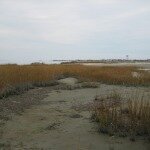Digging into the Past: Analysis of Sediment Cores Collected on Plum Island
January 28, 2015 by Chris Hein
By: Justin Shawler & Claudia Shuman
Gloucester Point, VA
|
With snow having finally come to the warm shores of Gloucester Point (we’ll be nice and just say something shy of the 3’ covering most of New England . . . ), team scientists at the Virginia Institute of Marine Science (VIMS) have hunkered down for the winter. Although field operations shut down early in the season, science marches on! In the VIMS sediment analysis laboratory, Ph.D. student Claudia Shuman and William & Mary undergraduate Justin Shawler are opening and processing sediment cores collected during earlier field work on Plum Island. Chris, Andy, and Luis collected these cores over this past summer using the team’s drill rig. The cores were extracted in four-foot sections, reaching depths of up to 48 feet! In the language of sedimentology, the deeper you go, the older you get. Therefore, these cores serve as a window into past depositional environments, telling us something about where the sediment in the core came from. Understanding how the source and supply of sediment to Plum Island changes through time is vital to the broader understanding of barrier island dynamics. The sediment cores, kept cold to preserve their organic components, undergo analysis as soon as they are opened. Upon visual inspection, each core can immediately tell us something about where its contents came from. We might, for instance, be greeted with a dark, organic-rich section, smelling strongly of sulfur (reminiscent of rotting eggs); such a layer would be indicative of deposition in an ancient marsh environment. In contrast, a lighter, courser-grained section with pebbles is indicative of sediment derived from a river (likely the Merrimack!) hundreds or thousands of years ago. Following initial visual inspection, we prepare the core for both traditional photography and x-ray analysis by scraping off the top layer of sediment to create a level surface. Photography creates a permanent record of visual clues (such as color and grain size) indicating depositional environment. X-Ray analysis helps us to see beyond our initial visual observations, highlighting changes in sediment structure (for instance, laminations) that are not discernable to the naked eye. |
|
Claudia measures a core (left), operates the x-ray scanner (middle), and uses a Munsell soil color chart to make a visual observation of the core at hand (right). Photo credit: Justin Shawler. |
|
In addition to x-ray-assisted visual clues, we take note of sediment characteristics such as mud and organic content, grain composition, angularity, sorting, and color to determine sampling intervals within each core. Ideally, each sediment sample collected represents a unique time period in the geologic history of the Island. A maximum of 10 cm is collected per sample, but often much shorter segments are sampled due to shifts in major sediment characteristics. Claudia samples a core for eventual organic analysis. Photo credit: Chris Hein. The organic component of these samples will eventually be put through additional analyses to better constrain sediment origin and age. As scientists, we often rely on proxies to inform us about the nature of past processes. In this case, chemical signatures provide us with records of processes that shaped Plum Island’s past and present – and potentially other barrier islands like it! As Chris notes in the recent news article about our work, these cores provide a “vertical picture of how those horizontal ecosystems [barrier islands and marshes] moved or changed over time”. In the coming weeks, we will provide updates on progress being made with these cores. Stay tuned for another picture gallery and greater detail on what we’re discovering about Plum Island’s past! |


 January 28, 2015 - By: Justin Shawler & Claudia Shuman Gloucester Point, VA With snow having finally come to the warm shores of Gloucester Point (we’ll be nice and […]
January 28, 2015 - By: Justin Shawler & Claudia Shuman Gloucester Point, VA With snow having finally come to the warm shores of Gloucester Point (we’ll be nice and […] November 26, 2014 - Williamsburg, VA Two weeks ago, I had the opportunity to work with several collaborators from the University of North Carolina on a study of overwash […]
November 26, 2014 - Williamsburg, VA Two weeks ago, I had the opportunity to work with several collaborators from the University of North Carolina on a study of overwash […]